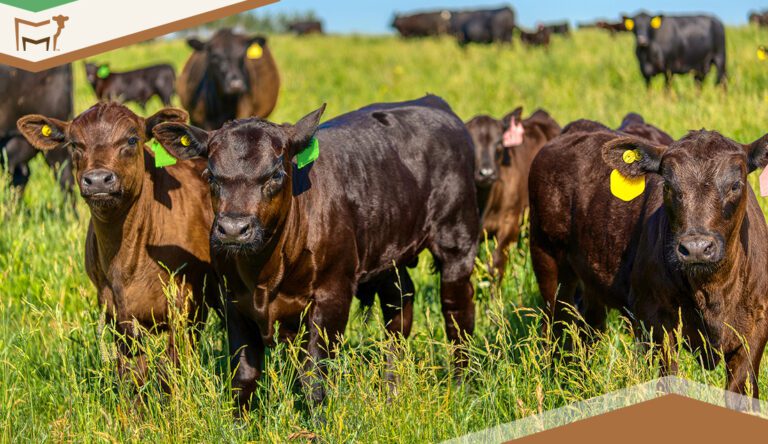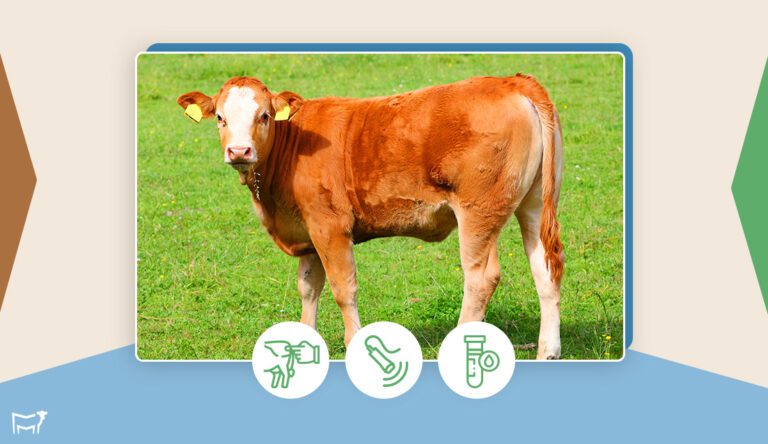Expert Guide: Mastering Cattle Pregnancy Checks for Maximum Herd Productivity

Some ranchers assume they can just eyeball a pregnant cow. But by the time you can see it, you’ve already lost precious weeks or months. Time is money in this business, and regular checks help you prepare in advance for the new, healthy calves.
Implementing regular checks may seem like an additional task in your already busy schedule. However, view it as an investment in the long-term health and productivity of your herd. The potential benefits – including improved calving rates, healthier calves, and better overall herd management – can far outweigh the initial time and financial investment. In this blog, we’ll look at various aspects of cattle pregnancy — why it’s important, 6 ways to tell if a cow is pregnant or not, how to manage pregnancy records, etc.
Whether your herd consists of a handful of cows or thousands, whether you’re focused on dairy or beef production, the insights shared here have the potential to transform your approach to cattle management.
Importance of Regular Cattle Pregnancy Checks
In this section, we’ll explore why these routine checks are far more than just a box to check—they’re a powerful tool that can transform your cattle operation. You might be surprised at how this seemingly simple practice can be a catalyst for positive change across your entire farming operation.
Here are some of the benefits of regular pregnancy checks in cattle:
- Early detection: Allows farmers to identify pregnant cows early, enabling better planning for the calving season.
- Culling decisions: Helps identify non-pregnant cows, allowing farmers to make informed decisions about culling or re-breeding.
- Nutritional management: Enables tailored feeding programs for pregnant cows to support fetal development and cow health.
- Health monitoring: Allows for early detection of potential pregnancy complications or health issues.
- Economic benefits: In an era where farming faces increasing challenges – from economic pressures to environmental concerns – maximizing efficiency is not just beneficial, it’s essential. Regular pregnancy checks are a powerful tool in this pursuit, offering benefits that extend far beyond mere reproductive management.
- Calving preparation: Helps farmers prepare facilities and resources for the upcoming calving season.
- Genetic improvement: Assists in planning breeding strategies and genetic selection for the next generation.
- Record keeping: Provides valuable data for herd management and future breeding decisions.
Cattle Pregnancy Check Methods

Here are three main cattle pregnancy check methods used by ranchers around the world:
1. Rectal Palpation: This traditional method involves a veterinarian or trained technician manually feeling the cow’s reproductive tract through the rectal wall. They can detect pregnancy as early as 35 days after breeding by feeling for the amniotic vesicle or the fetus itself. As the pregnancy progresses, they can feel the fetus, placentomes (attachment points of the placenta), and changes in the uterus size. This method is cost-effective and provides immediate results. It requires skill and experience to perform accurately and safely. While generally safe, there is a small risk of injury to the cow or fetus if not done properly.
2. Ultrasound Scanning: This method uses sound waves to create images of the cow’s reproductive tract. A probe is inserted rectally, allowing the technician to view the uterus and ovaries on a screen. Ultrasound can detect pregnancies as early as 28 days after breeding and can provide additional information such as fetal sex (after about 60 days) and viability. It’s highly accurate and allows for immediate results. While more expensive than palpation, it’s less invasive and provides visual confirmation. It also allows for the detection of twins and ovarian structures. The main drawbacks are the initial equipment cost and the need for specialized training.
3. Blood or Milk Testing: This method involves testing for pregnancy-associated glycoproteins (PAGs) in the cow’s blood or milk. PAGs are produced by the placenta and can be detected about 28 days after breeding. Samples are typically sent to a laboratory for analysis, with results available in a few days. This method is less invasive than rectal palpation or ultrasound and can be easily incorporated into routine health checks or milking. It’s particularly useful for confirming pregnancies in cows that have already tested positive by other methods. However, it doesn’t provide immediate results and can’t determine fetal viability or detect twins.
For large herds, you might prioritize speed and efficiency, making rectal palpation or ultrasound more appealing. Ultrasound equipment is expensive initially but can be cost-effective long-term for large operations. Palpation is generally the most economical but requires skilled personnel. Blood/milk testing has ongoing lab costs.
What is the Optimal Timing for Pregnancy Checks?
The optimal timing for pregnancy checks in cattle depends on the method used and the specific goals of your breeding program. Here’s a general rule you can follow: For rectal palpation, the earliest reliable checks can be done around 35-40 days after breeding. You can also wait until 45-60 days for increased accuracy and easier detection.
Ultrasound can detect pregnancies slightly earlier, from about 28-30 days post-breeding. For determining fetal sex, it’s best to wait until 60-80 days. Blood or milk tests for pregnancy-associated glycoproteins (PAGs) can be accurate from about 28 days after breeding.
However, the “optimal” time isn’t just about the earliest possible detection. Think about these factors as well:
1. Recheck timing: Early checks may need to be followed up to confirm pregnancies and check for early embryonic loss.
2. Management decisions: If you’re planning to cull or re-breed open cows, you might time checks to align with these decisions.
3. Breeding season length: In operations with longer breeding seasons, you might do multiple checks throughout the season.
4. Labor and stress considerations: Grouping checks to minimize handling stress and labor costs can be beneficial.
5. Accuracy vs. early detection trade-off: Later checks (60-90 days) generally provide more accurate results but delay management decisions.
Handling Non-Pregnant Cows
Handling Non-Pregnant Cows:
While it can be disappointing to find open cows in your herd, viewing it as an opportunity to improve your herd’s overall productivity can lead to better long-term outcomes for your operation.
It’s important to identify non-pregnant cows, often referred to as “open” cows as early as possible. This is where regular pregnancy checks come in handy. The sooner you know a cow isn’t pregnant, the quicker you can make decisions about her future in your herd.
Once you’ve identified an open cow, you have several options:
1. Re-breeding: If the cow is otherwise healthy and has a good history of fertility, you might choose to re-breed her. This is often the case if she’s a valuable animal genetically or has been a consistent producer in the past.
2. Culling: Sometimes, the most economical decision is to remove the cow from your herd. This is typically done if the cow has repeated breeding failures, is older, or if feed resources are limited.
3. Delayed breeding: You might decide to hold the cow over and breed her for a different calving season. This can be a good option if you have multiple calving seasons throughout the year.
4. Investigating health issues: If a typically reliable cow suddenly fails to conceive, it might be worth having a veterinarian check for any underlying health problems.
5. Nutritional assessment: Sometimes, fertility issues can be linked to nutritional deficiencies. Reviewing and adjusting your feeding program might be necessary.
When making these decisions, consider factors like the cow’s age, body condition, previous breeding performance, and the overall economics of your operation. It’s also important to look at patterns – if you’re seeing a higher-than-normal percentage of open cows, it might indicate a broader issue that needs addressing, such as bull fertility problems or nutritional deficiencies in your herd.
Keeping detailed records is crucial in this process. Good record-keeping allows you to track each cow’s breeding history, making it easier to spot patterns and make informed decisions. This is where digital tools like CattleMax can be incredibly valuable, allowing you to easily access and analyze this data.
Will Pregnancy Checks Give a Positive ROI?
Pregnancy checks in cattle are an investment that farmers make to improve their herd management and overall farm profitability. To understand whether this investment is worthwhile, we need to weigh the costs against the potential benefits.
The costs involved in pregnancy checks primarily come from veterinary fees if you’re bringing in a professional, or the cost of equipment if you’re doing the checks in-house. There’s also the time and labor involved in handling the cattle for these checks, which can be significant depending on your herd size. Some farmers might also consider the stress on the animals as a cost, albeit a non-monetary one.
On the benefit side, the value of pregnancy checks becomes clear when you consider the insights they provide. Knowing which cows are pregnant and which aren’t allows for much more efficient management of your herd. You can identify open (non-pregnant) cows early, which means you’re not wasting feed on unproductive animals. This alone can lead to substantial cost savings, especially in larger herds.
Pregnancy checks also enable better decision-making about culling. Instead of keeping an unproductive cow in the herd for months before realizing she’s not pregnant, you can make that decision much earlier. This improves your herd’s overall productivity and can have a significant impact on your bottom line. There are also less direct benefits. Regular pregnancy checks can help you improve your breeding program over time. You might identify cows that consistently conceive early in the breeding season, for example, which could improve your genetic selection process.
When you’re calculating the return on investment, you need to consider both the immediate and long-term impacts. In the short term, you might look at how many additional calves you’re producing or how much you’re saving on feed for open cows. In the long term, you might see improvements in your herd’s overall reproductive efficiency and genetic quality.
The breakeven point – where the benefits equal the costs – will vary from farm to farm. It depends on factors like your herd size, the cost of feed in your area, and the market price for cattle. However, many farmers find that even a small improvement in their calving rate can more than offset the cost of pregnancy checks.
Ultimately, while pregnancy checks do represent an upfront cost, they often prove to be a wise investment.
Keeping Pregnancy Records
Accurate pregnancy records are essential for efficient herd management. They help farmers track reproductive performance, plan for calving seasons, make informed culling decisions, and optimize feed allocation. Good records also aid in genetic improvement and overall herd health management.
Traditionally, ranchers have relied on simple methods to track pregnancies. Many still use paper logbooks, jotting down breeding dates and pregnancy check results. Others have moved to basic digital tools like spreadsheets or Google Sheets. While these methods are certainly better than no records at all, they often fall short when it comes to managing a complex, growing operation.
Paper records can be lost, damaged, or simply become unmanageable as your herd grows. Spreadsheets offer some improvements, allowing for basic sorting and filtering, but they lack the specialized features needed for comprehensive cattle management. As your operation grows, you’ll likely find yourself spending more time managing your records than actually working with your cattle. You might miss important dates, overlook potential health issues, or struggle to make informed breeding decisions because your data is scattered or incomplete.
This is where specialized software like CattleMax comes in. It’s designed specifically for the needs of cattle ranchers, offering a comprehensive solution for tracking pregnancies and much more. With CattleMax, you can:
- Easily record breeding events
- Log pregnancy check results
- Automatically calculate due dates.
The software connects all aspects of your herd management, from breeding to calving to health records, giving you a complete picture of each animal’s status and history.
Unlike basic spreadsheets, CattleMax offers features tailored to ranching operations. You can quickly update records for entire groups of cattle, track pasture rotations, manage AI and embryo transfer programs, and even keep tabs on your semen inventory. These specialized tools can save you hours of work and help prevent costly mistakes.
Having all your data in one place allows for better analysis and decision-making. You can easily identify your top-performing animals, spot potential health issues early, and make informed culling decisions. This level of insight is hard to achieve with paper records or basic spreadsheets. Claim your free trial of CattleMax here. If you want to make sure this tool is the right one for you, schedule a demo with a CattleMax expert.

Jacqueline
Jacqueline, a true Wyoming native, was raised on her family's ranch just north of Cheyenne. Her journey led her to the University of Wyoming, where she earned a Bachelor of Business Administration in Management and Marketing. She and her husband, Darrell, manage a thriving herd of commercial Angus cattle.

